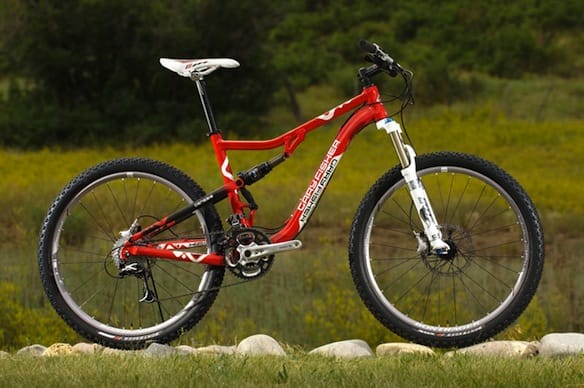
Image credit: Bike Magazine.
Gary Fisher Company Profile
By Paul Carroll
Gary Fisher the man and Gary Fisher the bike company are hard to separate. The Fisher name has become synonymous with the history and evolution of mountain biking. And for good reason: Gary Fisher was on the ground floor in the early days of the legendary “Repack” race down the hillsides of Marin County, California in the mid-1970s. He modified early Schwinns with drum brakes and multiple gears to give them more control and gearing for the steep ups and downs of the bucolic coastal hills.
Fisher and housemate-partner Charlie Kelley started “Mountain Bikes” in 1979 and built their pioneering off-road bicycles until 1983 when the company dissolved. Fisher went on to start his own company and in 1991 – as mountain biking was taking off worldwide – sold to Taiwanese firm Anlen, staying on as president of his own brand. The Fisher name and brand was then acquired by bike industry behemoth Trek in 1993. With the manufacturing and marketing capacity taken care of, Fisher was able to focus on his innovations and creativity to help the Fisher brand become a key part of the Trek Corporation.
In 2010, Trek announced the “Gary Fisher Collection, a line of Trek bikes that will replace the standalone Gary Fisher brand” according to Trek’s press release. Gone are the days of Fisher’s bikes sporting his iconic name. Now the Trek name and logo is the main logo. But the DNA remains pure Fisher: fun, performing, and designed to inspire the cyclist in all of us.
Mountain Bikes in the Trek Gary Fisher Collection
Trek lists 34 models in the Fisher Collection under its mountain bikes. It makes it hard to tell where the true Gary Fisher bikes end and the Trek ones begin. But given that Trek lists more the 80 models of mountain bikes overall – with strict downhill racers and technical singletrack lines distinct from the Fisher Collection – there is some degree of separation to be made.
The Fisher Collection of mountain bikes begins with the entry-level Wahoo for about $630 new and has the lowest grade components and features that one would expect at this price point. The designs and their features progress steadily up the chain to the top-end Superfly 100 Pro SL at just over $9,000. Suffice to say that with nearly three dozen models to choose from, everyone from the first-time off roader to the most elite racer can find their fit.
Cyclocross
Since Trek is known for its racing bikes, there are no Fisher Collection pure road bikes. But there is a menu of ‘cross bikes under the Fisher line. Two complete Ion models and one frameset; and two Cronus bikes and a frameset. Ion represents the lower end of the ‘cross selection, but at $1700 the Ion CX is no cheapie. It features an aluminum frame and Shimano 105 components along with Bontrager wheels and headset.
The upper echelon Cronus models are pricer – the CX Pro is offered at $2,940 and will get you Trek’s patented OCLV carbon frame, Shimano 105 brakes and shifters, FAS cranks and a SRAM 10 speed cassette. Other parts are of the quality one would expect at this price.
Dual Sport
The “DS” and “Neko” model lines purport to be versatile and all the bike you need if you can only have one. These designs and set-ups are reminiscent of the “hybrid” bikes from the 1990s when road and mountain bike features were merged to provide some of both. The result often turned out to be the lesser of both worlds; but with new materials and designs, Trek – using the Fisher philosophy of just getting people riding – may have learned from the past.
Trek offers nine models in its Dual Sport line. There are six “DS” models beginning with the DS 8.1 and going up in price and quality from there to the DS 8.6. The entry-level 8.1 retails for $530 and features an aluminum frame, a mix of entry level Shimano components, 700c wheels and V-brakes. The 8.6 is essentially the top of the line with the same frame but substantially upgraded components – a mix of Deore XT drivetrain and shifters and hydraulic disc brakes. Depending on your price point and desires, each model provides a bit more quality for about $200 more per step.
The three models that make up the Neko line range for $560 to about $900 and are basically “women’s versions” of the DS line, but with curved top tubes and different color schemes. All told, the Trek-Fisher “Dual Sport” line has 11 bikes that top out at well under $2,000. Not about performance on the road or on the trails, these are designed to be versatile.
Utility
Finally, Trek is meeting the market demand for truly utilitarian bikes with its two Transport models under the Fisher Collection. The Transport, at $1,390, offers an extended rear frame complete with racks, a center kickstand, and features that make cargo carrying and day/night riding safe and convenient. The Transport+ comes in at $2,800 and includes an electric motor rear hub for those times when a little help is needed.
With Trek evolving its product line and altering the Gary Fisher stamp on its products to the current approach of “honoring” his legacy, we may be witnessing the slow vanishing of the purebred Fisher machine. Gone are the days of seeing a Fisher Hoo Kee E Koo or Tassajara cruise along fire roads. The Trek brand is now front and center, with simply a nod to the contribution of Fisher. The imprint the man has made on cycling – particularly mountain biking – is being recognized. Trek will do well by staying true to his passion and innovations.



